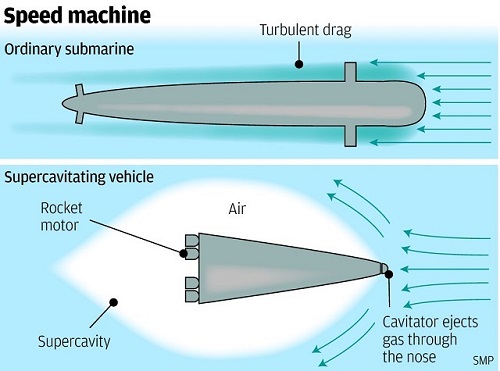Submarine: Shanghai to U.S. in 100 Minutes

China is working towards the creation of a supersonic submarine that could in theory travel from Shanghai to San Francisco in less than two hours.
New technology developed by a team of scientists at Harbin Institute of Technology's Complex Flow and Heat Transfer Lab has made it easier for a submarine, or torpedo, to travel at extremely high speeds underwater, reports the South China Morning Post.
Professor Li Fengchen says he can create the complicated air bubble required for rapid underwater travel. Air produces less friction that water, so without this development, conventional submarines cannot travel as fast as, say, an aircraft.
During the cold war, Russia developed supercavitation which involves enveloping a submerged vessel inside an air bubble to avoid water drag. This enabled a torpedo called Shakval to reach a speed of 370km/h.
 In theory, a supercavitating vessel could reach the speed of sound underwater, about 5,800km/h, which would reduce a transpacific journey to about 100 minutes, according to a report by California Institute of Technology in 2001.
In theory, a supercavitating vessel could reach the speed of sound underwater, about 5,800km/h, which would reduce a transpacific journey to about 100 minutes, according to a report by California Institute of Technology in 2001.
Up until now, one problem associated with the technology is the need to launch the underwater vessel at speeds of close to 100km/h to generate and maintain the air bubble. Also, conventional steering with a rudder is impossible without contact with water.
Li and his team have developed a way for the supercavitation vessel to be constantly showered by a special liquid membrane on its own surface to significantly reduce drag on the vessel at low speed. Then once it has reached 75km/h it would enter its supercavitation state. The liquid membrane on the vessel surface would also help with steering.
However, Li said many problems still need to be solved before supersonic submarine travel becomes feasible. Besides the control issue, a powerful underwater rocket engine still had to be developed to give the vessel a longer range. The effective range of the Russian supercavitation torpedoes, for example, was only between 11 and 15km.
Li says the concept could also be used to create low-drag swimsuits making swimming seem like flying in air.
